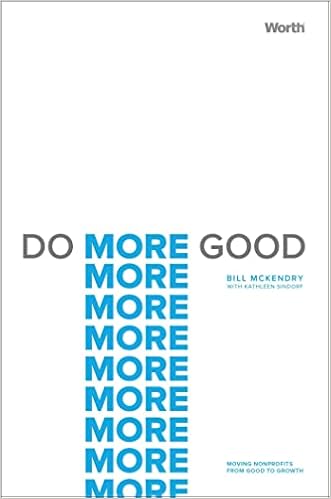Renowned branding expert and business leader, Bill McKendry will be releasing his new book in January 2022. In DO MORE GOOD: Moving Nonprofits from Good to Growth, McKendry provides a framework for nonprofit professionals to build brand awareness and increase impact, donor support and community involvement.
At the height of his successful 35-year career in advertising, marketing and branding, Bill stepped away from a large agency to launch his nonprofit, DO MORE GOOD®, to provide content, thought leadership, and educational conferences and workshops for nonprofit organizations. Bill now uses his knowledge from decades of leading successful campaigns for notable clients such as American Express, Meijer, Rubbermaid, Target Stores, Owens Corning, Kohler, 5 Hour Energy, Taco Bell, Alliance Defending Freedom, Salvation Army, CURE International, Young Life and World Vision to help current nonprofits magnify their mission and multiply their impact.
Q: Bill, thank you for doing this interview with us. Let's start with yourself: you were raised by two deaf parents; how did that affect you?
Needless to say, being raised in a household where both parents were deaf from birth has profoundly impacted me, I credit this upbringing with the reason I have a strong desire to be a voice and communicator for those who need help.
As such, I see my career in marketing and communications not just as a career, but as a calling. Because so much about marketing and communications is about translating the vision and dreams for an organization to priority constituents, having been a translator for my parents in my youth gave me early training on how to communicate clearly and, at times, urgently. When I tell people I was helping my parents negotiate a mortgage or car deals before I was 10 years old, it's not a surprise that my ability to communicate was enhanced by those experiences. One of the more memorable situations I was called to translate was a time I had to translate to my mom in the emergency room during surgery because she was in a car accident and there wasn't time to call in an outside interpreter. I remember being 16 at the time and not that fond of hospitals or blood, but staying focused on my mom's situation and communication needs got me and her through a challenging situation.
All to say, I used to see all these experiences as not ideal because none of my friends had that responsibility with and for their parents. However, today, I'm thankful because it has helped me a great deal in my profession and life.
Beyond that, my parents were great role models in not allowing their deficits (not being able to hear and speaking sign language) to be a handicap. While we were definitely not a wealthy family, we were rich in lessons about overcoming obstacles with grace and determination.
Q: You have a heart to encourage leaders of non-profit organizations, how did that passion begin?
I can easily point to my upbringing. With sign language as my first language and needing to communicate for my parents, this situation created a natural incubator to understand the necessity and power to communicate effectively.
When working with nonprofit leaders, I know it's easy for them to get weighed down by a multitude of operational and day-to-day tasks. However, especially today with so many things vying for attention and support, being able to communicate and actually making it a priority is essential. I often point out that the title of CEO today stands for Chief Engagement Officer ... which means nonprofit leaders ARE the marketing and communication leaders within their organization. As such, they set the standard for how well and how seriously their organizations are going to harness the power of compelling communications to motivate the behaviors they need to grow their awareness, impact and returns.
Too often, nonprofits fall into the trap of believing they are the cause. Reality is, they are a conduit to helping the cause or issue they are hoping to address, advance or eradicate. So their mindset needs to change from their "purpose" is the cause and needs to shift to their purpose is to raise awareness and support for the cause. While this realization is sometimes tough to accept, but once a nonprofit and their leadership clearly understands this vital and important role, they begin to understand why marketing and communicating is so necessary.
Q: I believe you did film a commercial with Mother Teresa, tell us more about it.
We filmed Mother Teresa in 1996 about one year before she passed away. The location was in a convent in Washington DC and was before an evening engagement at The White House hosted by President Clinton to honor her 40th Anniversary of serving the poor in Calcutta.
The project required a big production crew and several cameras so that we made sure we captured her and her thoughts in the most impactful ways possible. While we were setting up, there were some pre-production protocols we needed to address. One standard practice is to get a signed model release before filming.
While it seemed crazy to ask Mother Teresa to sign a model release, to legally protect everyone involved, it just needed to be done. Representing Mother Teresa was a younger nun, Sister Sylvia, who was acting as her handler. Mother Teresa was eighty-six years old at the time, so Sister Sylvia was, my guess, about seventy-two years old. She and I reviewed the contents of the model release and other documents that needed to be signed to get our paperwork in order.
During our discussion, Sister Sylvia asked me to explain what I did, what my mission and business was about. In a nutshell, I explained that I helped organizations to communicate more powerfully and persuasively-which then would help them raise the support they need so they don't just do good- they can do even greater good.
I said, "Maybe you know, Peter Drucker says a nonprofit organization's purpose isn't just the cause it's working for, but even more, its purpose is to raise the donors and funds needed to make the impact they are hoping to make. And like the business world, it takes resources to grow your impact, so communications and marketing provide the fuel needed to grow."
At this point, I was sure I had lost this sprightly seventy-two- year-old nun with my diatribe. Instead she looked at me and said, "I get it, Bill."
I responded, "Sister, I mean no disrespect, but I know a lot of really smart nonprofit CEOs who don't get what I just said. Can you tell me, in your own words, your understanding of this concept? We're a relatively new firm, and I'd love to know what I have said that might have resonated with you."
She said, "Mother Teresa and I talk about this topic all the time. We use a different wording to describe our needed focus on getting support, and it's this: 'No margin, no mission.'"
She then went on to say, "Do you think Mother Teresa really wanted to come to America and speak at the White House? No, not really. She would prefer to be back in Calcutta, helping people. Do you think she really wants the attention that goes with accepting awards like the Nobel Peace Prize? No, she doesn't seek any attention. She wants to stay in Calcutta and give her attention to the people there. But the reason she gets on a plane, comes to Washington, D.C., or goes to accept the Nobel Peace Prize in Sweden, the reason she does all this stuff at the age of eighty-six is because she understands, 'No margin, no mission.' If we don't raise money and awareness, we can't help the people we really want to help."
That statement "No margin, no mission" stuck with me, and it's forever impacted the way I look at nonprofit organization marketing. Mother Teresa got it. And so did Sister Sylvia.
They understood why communicating your needs powerfully is so vitally important. If the Missionaries of Charity (the nonprofit Mother Teresa founded) didn't have the public awareness and financial support it needs, it wouldn't be able to continue its amazing work. It wasn't Mother Teresa's desire to be filmed or attend a fancy dinner in her honor. She much preferred to put on her sandals and serve the poor and sick and abandoned people of India, but she was wise enough to realize that she couldn't continue to do that good work-as famous and admired as she already was-if she didn't find ways to tell people about it! She wanted to do more good! And did she ever!
Q: Tell us about DO MORE GOOD and your role in it.
I am the founder and board president of DO MORE GOOD®, which has now combined efforts with Nonprofit HubTM and Cause CampTM, to provide content, thought leadership, educational conferences and workshops for nonprofit organizations. Cause Camp has been ranked by Forbes® as one of the "must attend" conferences for nonprofit leaders. The combined entity now speaks to and is followed by over 50,000 nonprofits globally.
Q: You have also written a book about this, tell us more about the content of the book.
Do More Good is about using my 35+ years of knowledge and experience to help nonprofit organizations expand their reach and results by becoming more effective communicators. Through practical examples and stories from my own life and career working with some of the world's largest brands as well as serving over 300 nonprofits and speaking at 200+ nonprofit executive events, my hope is to provide leaders and readers with a blueprint and a roadmap for increasing organizational returns and impact.
Q: Why did you write this book?
My hope is that Do More Good is an invaluable resource for all people involved in nonprofit work. After the devastation the nonprofit industry has faced the past two pandemic years, I am wanting to offer a path toward future success with practices that have proven results of growth in notoriety, donor support, community involvement and more. As nonprofit professionals continue striving to add more good to the world, finding ways and insights to express, not just your "why", but "how big is your why" and why it makes a difference is crucial to connecting with all audiences, especially the next generation of volunteers and change-makers.
Q: What are three simple ways to do more good for the causes and things you care about?
A few simple aspects that will improve results for nonprofits as they look to grow awareness and support are:
1. Touch (and Manage) Every Touchpoint | Make sure that an organization understands that every touchpoint within and from an organization is important. How your lobby looks, what your emails are like, what your voicemail message sounds like are key touchpoints. While I tend to be a big messaging guy, it never surprises me anymore how much impact the little details have on people and organizational success.
2. Understand You Need Both an Air Attack and Ground Attack | Winning the battle for the heart, mind and resources requires more than just a staff fundraising person. Deploying frequent, awarenessbuilding efforts to your approach to increasing attention and support is key to growing and doing more good. Fundraising is your ground attack, efforts you do to grow awareness (social media, PR, marketing, etc.) are the air attack you need to create an environment for greater success.
3. Stop Believing in "Once Upon A Time" Fairy Tales | So many organizations rely on too few tactics to grow their awareness and support. An annual outing, banquet, event or activity. Leaving your success and growth to infrequent contacts and year-end appeals is not only ineffective, it's high-risk. When/if you read the book, you'll see how important it is to build relationships with those who support you and you do so through frequent, high-value and high-quality contacts and connections.
Q: What are some of the major take home lessons readers can get from your book?
Some major takeaways are:
• Understand Your Competition | Nonprofits don't really compete with each other; rather, they compete with the consumer market for discretionary time and money. Once a nonprofit leader understands they are in competition with Apple, Nike and Coke, they will realize they need to rise to that challenge and be better at communicating their vision and purpose in the most compelling ways possible. I started down this road in helping nonprofits after being very successful in marketing consumer products and services (things like Target Stores, American Express and Taco Bell). After doing so for a while, I realized the voice of consumerism was extremely powerful and it was eroding the time and resources given to charity, faith and human kindness. In 1994 I set out to be a counterbalance to these competitive forces and to help organizations already doing good to do more good.
• Frequency Wins | Any successful organization, business, celebrity, athlete, politician or cause understands when you do something well and you do it frequently, that this is a big part of their success equation. Engaging people and doing so with quantity, quality and variety will provide your organization with an unmatched and sustainable advantage.
• Become A Brand, Not Just An Organization | Top-level success and impact are most always associated with an organization's ability to become a known brand. Do More Good provides practical methods and a roadmap on how an organization can manage and sustain a marketing and communications effort that grows your brand and, as a result, the good that you can do.
To purchase the book, click HERE.



















